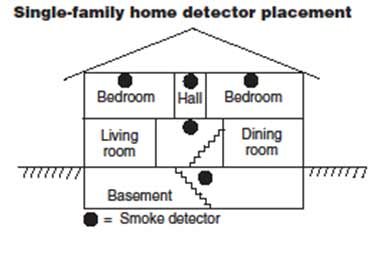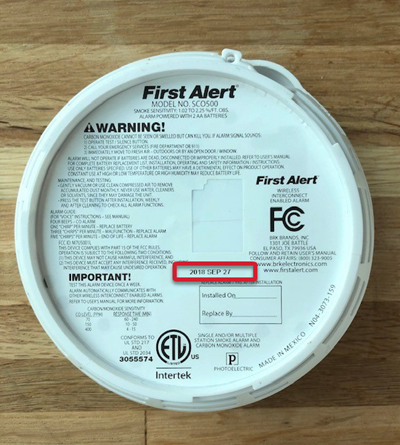The Importance of Replacing Smoke and CO Detectors and their Batteries, Also Why You Should Own a Weather Radio
The Importance of Replacing Smoke and CO Detectors and Their Batteries
Your home’s first defense against fire and carbon monoxide (CO) hazards is a fully functional smoke and carbon monoxide detector. These small, often overlooked devices can be the difference between life and death in an emergency. To ensure your family’s safety, it’s essential to maintain these detectors by regularly replacing both the devices and their batteries. With Fall in the Air, we will talk about why, when, and how to replace smoke and CO detectors and their batteries.
Why It’s Crucial
Smoke and CO detectors alert you to dangerous situations that can escalate rapidly. Smoke detectors sense early signs of fire, giving you and your family precious time to escape, while CO detectors detect harmful levels of carbon monoxide—an odorless, colorless gas that can be fatal when inhaled.
Over time, according to the National Fire Alarm and Signaling Code (2010 edition), all smoke alarms, including smoke alarms with ten-year batteries or that are hard-wired, need to be replaced when they are ten years old or sooner. CO alarms should be replaced every seven years, though. If you have a combination CO alarm and smoke alarm, that should be replaced every seven years.
You want to change your smoke alarms every ten years because the way the smoke alarm detects the presence of smoke can become clogged or malfunction with age. If that occurs, your alarm might not be as efficient at detecting smoke when it is present. Thus causing the alarm to possibly not go off. Back in the day, many used to say the yellowing of a smoke detector was tied to a home with someone who smoked inside, but a white smoke alarm becoming yellow is an indication of age. If your smoke detector is yellow in color, it would be a wise choice to check your manufacturing date.
The red square highlights where you can find the manufacturing date on most standard smoke alarms.
When to Replace Smoke Detectors and Batteries
1. Smoke Detectors:
Most smoke detectors need to be replaced every 10 years. Check the date of manufacture on the back of the detector. If it’s older than 10 years, it’s time for a replacement. Newer models often come with long-lasting sealed lithium batteries, but older detectors use replaceable batteries.
2. Smoke Detector Batteries:
For smoke detectors with replaceable batteries, it's recommended to replace the batteries once a year, or sooner if the device starts chirping, indicating low power. Many experts suggest replacing them at the same time you adjust your clocks for daylight saving time to help you remember.
3. CO Detectors:
Like smoke detectors, CO detectors should also be replaced every 5-7 years, depending on the manufacturer’s guidelines. They often come with a “replace by” date, so make sure to check the label. Newer models may feature long-lasting, sealed batteries, eliminating the need for annual replacements.
How to Replace and Maintain Smoke and CO Detectors
Step 1: Turn off the Power (if hardwired):
If your smoke detectors are hardwired into your home’s electrical system, switch off the power at the circuit breaker before beginning any replacements to avoid electrical shock.
Step 2: Remove the Old Detector:
Detach the old smoke or CO detector by twisting or unscrewing it from its mounting bracket. Disconnect any wires (if hardwired), and safely dispose of the old detector according to local guidelines.
Step 3: Install the New Detector:
For battery-powered detectors, simply insert the recommended batteries into the new unit. For hardwired detectors, connect the new device to the existing wires before mounting it onto the bracket.
Step 4: Test the Detector:
After installation, press the test button on your smoke and CO detectors to ensure they are working properly. You should do this monthly to maintain device effectiveness.
Step 5: Schedule Regular Maintenance:
Beyond replacing the detectors and batteries, it's also important to clean your smoke and CO detectors every six months. Dust and debris can interfere with their sensors, so gently vacuum the exterior and use a dry cloth to wipe them down.
Additional Tips for Safety:
Interconnected Systems: Consider upgrading to an interconnected alarm system, where if one detector goes off, they all do. This ensures you’ll hear an alarm even if a fire starts in a remote part of your home.
Combo Detectors: Many new devices combine both smoke and CO detection, simplifying maintenance and increasing overall safety coverage.
Location Matters: Ensure that smoke detectors are installed on every level of your home, inside each bedroom, and outside sleeping areas. CO detectors should be placed near sleeping areas and on every level of the home, especially near any fuel-burning appliances.
Replace batteries at least once a year.
Test smoke detectors monthly.


Graphics provided by the Bloomington, Minnesota Government.
The Importance of Having a Weather Radio
In addition to smoke and CO2 detectors, another critical safety device for your home is a weather radio. While smartphones and internet-based alerts are helpful, they may fail in emergencies when power or communication networks go down. A dedicated weather radio ensures you’ll stay informed during extreme weather events, providing critical updates and warnings when you need them most.
Why a Weather Radio is Essential
A weather radio is designed to receive official emergency broadcasts from the National Oceanic and Atmospheric Administration (NOAA). These broadcasts include information about severe weather conditions like tornadoes, hurricanes, floods, and blizzards, as well as other hazards like chemical spills or AMBER alerts. In times of emergency, these radios transmit life-saving warnings, often before traditional news outlets or cell phones can deliver the information.
The most significant advantage of a weather radio is its reliability. Most models operate on battery or hand-crank power, making them indispensable during power outages. With the push of a button, you can receive real-time updates on changing weather conditions in your area, even when the internet is unavailable.
Key Features of a Good Weather Radio:
NOAA Alerts: Ensure your weather radio can receive alerts from NOAA for your specific location. Many radios offer automatic alerts that sound when a warning is issued.
Multiple Power Options: Look for a radio that offers different power sources, such as rechargeable batteries, solar panels, or a hand-crank generator. This ensures you have power when you need it most.
Portable and Durable: In case of an evacuation, having a portable and sturdy radio that you can take with you is crucial.
Emergency Lighting and Charging: Many weather radios come with built-in flashlights and USB ports to charge your phone or other devices in an emergency.
When to Use a Weather Radio
Severe weather can strike unexpectedly, and early warnings are often the difference between safety and danger. A weather radio should be part of your emergency preparedness plan, and you should use it during:
Storm Watches and Warnings: Tornadoes, hurricanes, and severe thunderstorms can develop quickly. A weather radio provides immediate updates on warnings specific to your area, even in the middle of the night when other devices might be muted.
Natural Disasters: Floods, wildfires, and earthquakes can damage communication infrastructure, but a weather radio will continue to function.
Extended Power Outages: In long-term outages, weather radios provide a reliable source of information, allowing you to monitor conditions and recovery efforts.
Weather Radios that We Recommend: Midland - WR120B
Disclaimer: Limitless Production Group LLC is a participant in the Amazon Services LLC Associates Program, an affiliate advertising program designed to provide a means for sites to earn advertising fees by advertising and linking to Amazon.com Amazon, AmazonSupply, and the AmazonSupply logo are trademarks of Amazon.com, Inc, or its affiliates. Wight Photography also accepts forms of cash advertising, sponsorship, paid insertions or other forms of compensation. This compensation does not influence the content, topics, or posts made in this blog. All advertising is in the form of advertisements generated by a third-party ad network. Those advertisements will be identified as paid advertisements.
Written by: Will Wight



